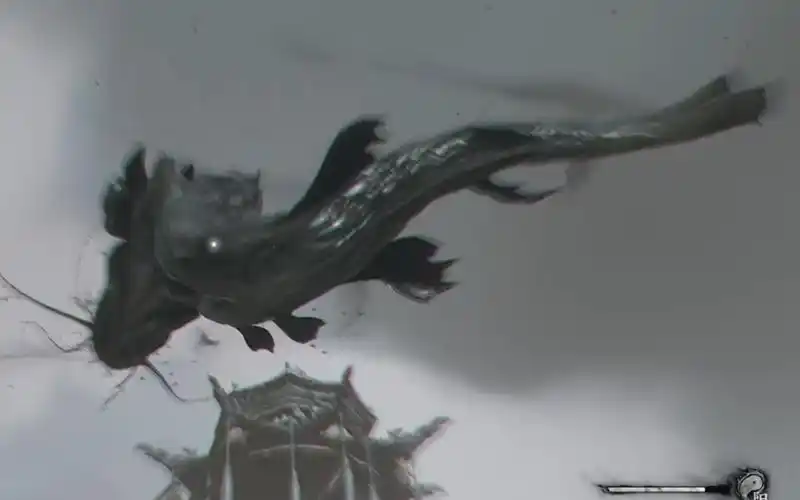In this installment, the Destined One will encounter various bosses such as Flint Chief, Cloudy Mist, Misty Cloud, Keeper of the Flaming Mountains, and Yin-Yang Fish. This segment will introduce two characters: Keeper of the Flaming Mountains and Yin-Yang Fish.
In Chapter Five of “Black Myth: Wukong,” we meet the Keeper of the Flaming Mountains. According to his background, the Keeper of the Flaming Mountains originally served as a Disciple under Taishang Laojun, assisting in Alchemy. Rakshasi became Taishang Laojun’s disciple too, thus becoming the Senior Sister to the Keeper of the Flaming Mountains. The Keeper never expected that Taishang Laojun, a typically stern figure, would show such warmth and favor towards Rakshasi. Coupled with Rakshasi’s beauty and empathetic nature, the Keeper of the Flaming Mountains gradually fell for her.
Afterward, the two practiced and cultivated together. He discovered that the girl practiced Dual Cultivation of Buddhism and Taoism. No matter what scriptures the master discussed, the girl could always add a few remarks, whereas he found himself unable to keep up verbally, and his thoughts also fell behind. Later, due to Sun Wukong’s Havoc in Heaven, which resulted in the destruction of Taishang Laojun’s furnace, the Keeper of the Flaming Mountains was severely punished by the master, demoted from the Celestial Realm, and became The Keeper. His fellow disciples looked on indifferently, only Rakshasi spoke up for the Keeper of the Flaming Mountains, which was one of the reasons he secretly loved Rakshasi. Afterwards, in an effort to return to the Celestial Court, the Keeper of the Flaming Mountains continuously engaged in dirty work for Taishang Laojun, inevitably doing many bad deeds.
Later, Rakshasi was promised by Taishang Laojun to Bull King. The Keeper of the Flaming Mountains knew he was not worthy of Rakshasi, but his heart still longed for her. After being demoted to the mortal world, the Keeper of the Flaming Mountains, in his effort to return to the Celestial Court, utilized his status as Tudigong to help Taishang Laojun with dirty tasks. In the story of the Yin-Yang Fish, the Keeper of the Flaming Mountains used the Yin-Yang Fish to bring plague to a village, causing great suffering to its inhabitants.
In the backstory, it was recorded that the Keeper of the Flaming Mountains deliberately spread plague to sow discord among the monkeys fleeing from Mount Huaguo after the death of Sun Wukong. Many of Sun Wukong’s descendants escaped to the Flaming Mountains, where they endured severe hardships. Initially, the Keeper of the Flaming Mountains feigned kindness by providing food to the monkeys, but secretly released a plague. This disease caused the monkeys to continuously lose fur and suffer from skin ulcerations and large, dark abscesses on their backs, a truly horrifying sight. The former leader, Macaque Chief, had no choice but to abandon them, tossing them into the depths of Furnace Valley to prevent the spread of the disease. Just when they were about to die from the illness, the Keeper of the Flaming Mountains miraculously saved them with a potent elixir and took them under his wing. After being enlisted, the monkeys then attacked Macaque Chief’s camp, leading to the escape of Macaque Chief alone, who could only flee to Minor Western Heaven to seek refuge with Yellowbrow. In Chapter Five, Red Boy kills the Keeper of the Flaming Mountains to seize the Breath-Holding Talisman.
What, then, is the Yin-Yang Fish? It is a large fish from the South Sea, over six feet long, with knife-like dorsal spines. It can change color from black to white, fly into the sky, and whip up massive winds and towering waves. Every time it appears, a plague breaks out in the village.
Additionally, the Yin-Yang Fish also refers to the Tai Chi symbol, known as the “foremost diagram of China.” This widely recognized Tai Chi symbol, shaped like two intertwined fish representing Yin and Yang, is thus commonly known as the “Yin-Yang Fish Tai Chi symbol.” The presence of the Yin-Yang Fish is widespread, appearing on the beams of Taoist temples, the robes of Taoist Priests, at Fortune-telling Stalls, in Traditional Chinese Medicine, Qigong, Martial Arts, and on the covers of books about traditional Chinese culture.
The Yin-Yang Fish, also known as the Tai Chi symbol, is one of the significant symbols in Chinese Taoist culture. It consists of a circular pattern featuring two interlocking shapes: one is black, representing “Yin,” and the other is white, representing “Yang.” Each shape contains a small circle of the opposite color – black contains white, and white contains black – symbolizing the interdependent and transformative relationship of Yin and Yang.
The design of the Yin-Yang Fish symbolizes the unity and opposition between Yin and Yang. The closely interconnected black and white parts display the philosophical idea that within Yin there is Yang, and within Yang, there is Yin. This reflects how opposing forces in nature depend on each other to maintain balance. The curvilinear shape of the Yin-Yang Fish in the Tai Chi symbol signifies change and movement. The transformation of Yin and Yang is dynamic, continuously cycling, and this perpetual change maintains overall harmony and balance.
The circular foundation of the Yin-Yang Fish pattern symbolizes wholeness and completeness. It conveys that despite differences and opposition, everything ultimately unifies within a complete system. The Yin-Yang Fish also symbolizes the cyclical processes of nature, such as the changing seasons and the alternation between day and night. It reminds people to respect natural laws and live harmoniously with nature.
In Taoism, the Yin-Yang Fish is a central expression of Tai Chi philosophy, influencing many aspects of Chinese philosophy, religion, and medicine.  The Yin-Yang Fish is commonly found in traditional Chinese art, such as paintings, sculptures, and architectural decorations, embodying the aspiration for a harmonious and beautiful life. In traditional Martial Arts like Tai Chi, the concept of the Yin-Yang Fish is also applied to guide movements that are soft yet firm, using softness to overcome hardness, and emphasizing the cultivation of both internal and external aspects.
The Yin-Yang Fish is commonly found in traditional Chinese art, such as paintings, sculptures, and architectural decorations, embodying the aspiration for a harmonious and beautiful life. In traditional Martial Arts like Tai Chi, the concept of the Yin-Yang Fish is also applied to guide movements that are soft yet firm, using softness to overcome hardness, and emphasizing the cultivation of both internal and external aspects.
In modern design, the Yin-Yang Fish is often used as a symbol of balance and harmony, widely applied in commercial logos, brand designs, and other areas. The Yin-Yang Fish is more than just a visual pattern; it is a profound philosophical symbol within Chinese culture, conveying wisdom about balance, harmony, change, and unity.
